Stackpole Elidor is a small parish in the hundred of Castlemartin, about 3 miles from the County Town of Pembroke. The name is derived from the Stack rock at the mouth of Broad Haven, and the ancient Parish Church is attributed to St. Elidyr. The Parish has a long connection to the Earl’s of Cawdor, who had a fine residence locally at Stackpole Court, and is adjoined by the neighbouring Parishes of St. Petrox and Bosheston. The Church of St. Elidyr holds two brass memorial plaques for the fallen of both World Wars, plus two glass framed parchment scrolls, which commemorate the members of the Parish who served during both conflicts.
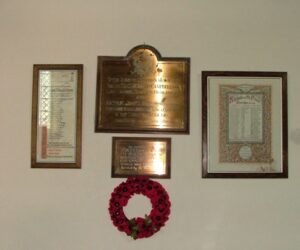
The Great War, 1914-1918
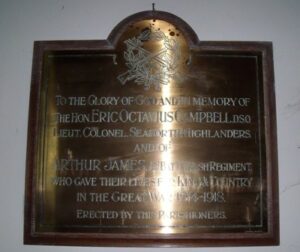
The Honorable Eric Octavius Campbell, DSO & Bar, Lieutenant-Colonel, Seaforth Highlanders. Eric was born on 3 December 1885, the youngest son of Frederick Archibald Vaughan Campbell, 3rd Earl Cawdor and Edith Georgiana Turner, Countess Cawdor, of Golden Grove, Stackpole Elidor and Cawdor Castle, Nairnshire. He was educated at Eton, and passed into the Army through the Militia, being gazetted to the Seaforth Highlanders on 20 December 1905. At the outbreak of the war be went to France as adjutant of the 2nd Battalion, Seaforth Highlanders. Eric was awarded the DSO on 18 February 1915, and was wounded at St. Julien on 25 April 1915. He was employed as brigade major from 3 January 1915 to 24 September 1916, his services being rewarded with a brevet majority on 3 June 1916. He was in hospital In France towards the end of 1918, and on return to duty in November went to the second battalion, but resumed the appointment of brigade major to 44 Infantry Brigade on 22 January 1917. Eric returned to regimental duty on 27 May 1917, and for a short time commanded the Second battalion. On 20 October 1917, he was given command of another battalion of the Seaforth Highlanders, which he retained till the middle of May, 1918, when a breakdown in health, due to nearly four years active service, compelled him to go to hospital. He arrived home on 25 May, having been repeated wounded, but returned to duty immediately, as he was only bruised by a fragment of a shell. In the Gazette of 24 May 1918 he was mentioned in dispatches for the third time, and a bar to his DSO was awarded in the Gazette of 3 June 1918. Sadly Eric died of cerebral haemorrhage on 4 June 1918 in Hospital in London. He was 33 years old, and was buried in the Cawdor Plot of Stackpole Elidor Churchyard, Pembrokeshire.
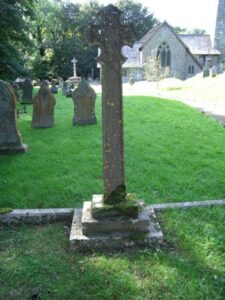
Arthur James, Private, 30642, Welsh Regiment. Arthur was the son of George and Eliza James, of Stackpole Quay, Pembroke. He enlisted at Pembroke into the 1st Battalion, Welsh Regiment. At the outbreak of war, the 1st Welsh were stationed at Chakrata, in India, and on 20 November 1914 sailed from Karachi and arrived at Plymouth on 22 December, joining 84 Brigade, 28th Division. On 18 January 1915 the 1st Welsh landed at Havre. The Division moved to positions near Ypres, where it took part in the Second Battle of Ypres. After suffering terrible casualties there, the Division moved to the Loos area, and took part in the Battle of Loos later that year. On 2 October 1915, the 1st Welsh took part in an attack on the Hohenzollern Redoubt. Arthur was one of many men killed that day as the Welsh gallantly fought their way across the battered Loos battlefield. He was 23 years old, and is commemorated on Panel 78 of the Loos Memorial, France.
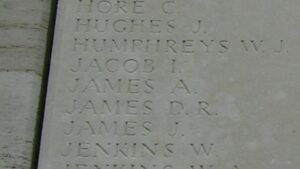
Frederick Long, Private, 27379, Welsh Regiment. Frederick was the son of George and Hester Long, of Garden Lodge, Stackpole, Pembroke. He enlisted at Pembroke into the 1st Battalion, Welsh Regiment, and served alongside Arthur James. At the outbreak of war, the 1st Welsh were stationed at Chakrata, in India, and on 20 November 1914 sailed from Karachi and arrived at Plymouth on 22 December, joining 84 Brigade, 28th Division. On 18 January 1915 the 1st Welsh landed at Havre. The Division moved to positions near Ypres, where it took part in the Second Battle of Ypres. After suffering terrible casualties there, the Division moved to the Loos area, and took part in the Battle of Loos later that year. On 2 October 1915, the 1st Welsh took part in an attack on the Hohenzollern Redoubt. Frederick was one of many men killed that day as the Welsh gallantly fought their way across the battered Loos battlefield, quite possible falling alongside his friend Arthur James. He was 23 years old, and is commemorated on Panel 78 of the Loos Memorial, France. Frederick is not commemorated on the brass plaque inside Stackpole St. Elidor Church, but is listed on the parchment roll of honour there, and also on a separate brass memorial within nearby St. Petrox Church.
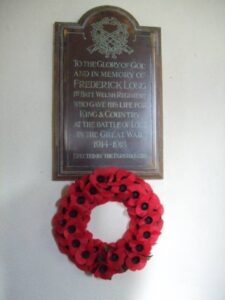
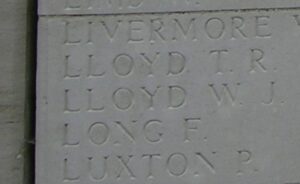
World War Two, 1939-1945

William Joseph Canton, Private, 5111738, The Royal Warwickshire Regiment. William was the son of John Henry Canton and Lilian Canton (nee Gwyther), of Stackpole. He enlisted into the army and served with the 1/7th Battalion, The Royal Warwickshire Regiment, a Territorial Army unit which had fought in France during the retreat to Dunkirk in 1940. Members of the Battalion were infamously murdered by the S.S. after their surrender. After the Normandy Landings of 6 June 1944, the 1/7th Warwicks landed at Queen Beach on 29 June. The first engagement for the 1/7th was on 8 July 1944, to capture the village of St Contest. It was a hard fought battle as they were up against the first-rate 25th SS Panzer Grenadiers. Even so by 6.30pm they had reached their objective having lost 26 men and 96 wounded. William was killed just days later, on 17 July 1944. He was 26 years old, and is commemorated on the Bayeux Memorial, France.
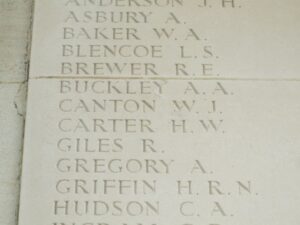
James Frederick Garlick, Sapper, 1875818, Royal Engineers. James was the son of Frederick George and Martha Garlick, of Pembroke. He was one of three siblings who served during the course of the war, and was a regular soldier, serving with 26 Field Company, Royal Engineers. James was in France with the BEF at the outbreak of war, and took part in the desperate defence of France and Belgium, attached to the 1st Division. James was killed during the retreat to Dunkirk on 20 June 1940. He was 20 years old, and is commemorated on Column 22 of the Dunkirk Memorial, France.
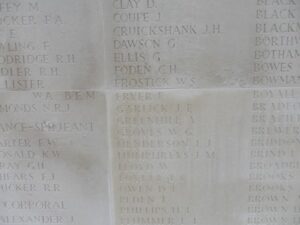
The Church of St. Elidor contains two parchment scrolls, which are displayed in framed glass cases. These rolls contain the names of the members of the Parishes of Stackpole and St. Petrox who also served during both World Wars.
The Great War, 1914-1918
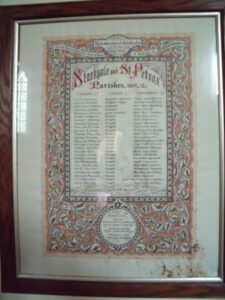
R. A. Stephens, Paymaster Lieutenant, Royal Navy
Lewis Morris, Sergeant Major, Royal Garrison Artillery
Walter Morris, Sergeant, South Wales Borderers
Alfred James, Sergeant, Welsh Guards
Norman Davies, Lance Corporal, Royal Welsh Fusiliers
Ernest Morgan, Private, Royal Engineers
Stanley Morris, Private, Royal Engineers
Thomas Evans, Private, Royal Warwicks
William Evans, Private, Royal Engineers
James Evans, Private, Pembrokeshire Yeomanry
Thomas Phillips, Private, Royal Field Artillery
George Bowen, Private, Royal Lancasters
William Morgan, Private, Royal Army Service Corps
William Canton, Private, Royal Field Artillery
Thomas Whelby, Private, Pembrokeshire Yeomanry
William Roch, Private, Royal Engineers
Albert James, Private, South Staffords
Ernest James, Private, 2nd Welsh Regiment
William Pritchard, Private, Royal Engineers
William Nicholas, Private, Royal Welsh Fusiliers
William G. Francis, Private, Pembrokeshire Yeomanry
Alfred Harries, Private, Royal Army Service Corps
Arthur Phillips, Private, Welsh Regiment
T. G. Edwards, Private, Loyal North Lancashire Fusiliers
John Davies, Private, Royal Field Artillery
T. J. Cole, Private, Royal Welsh Fusiliers
THAT DUTY CHEERFULLY DONE MAY BE A LASTING EXAMPLE
World War Two, 1939-1945
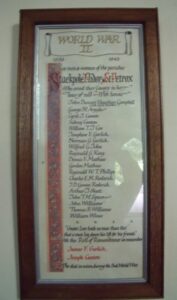
John Duncan Vaughan Campbell (8th Earl Cawdor)
George H. Argyle
Cyril J. Canton
William T. J. Cox
Josephine E. Garlick
Norman G. Garlick
Wilfred G. John
Reginald G. King
Dennis F. Mathias
Gordon Mathias
Reginald W. T. Phillips
Charles E. M. Roderick
J. D. Govan Roderick
Arthur J. Shutt
John T. H. Spure
John Williams
Thomas B. Williams
William Wines